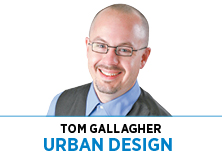Subscriber Benefit
As a subscriber you can listen to articles at work, in the car, or while you work out. Subscribe Now The pandemic has brought focus to so many things, especially the way we live in urban environments. Although urban places are complex systems that defy simple stereotypes, early assumptions about the spread of the virus have made clear that there are still deeply rooted biases and fears attached to city dwelling.
The pandemic has brought focus to so many things, especially the way we live in urban environments. Although urban places are complex systems that defy simple stereotypes, early assumptions about the spread of the virus have made clear that there are still deeply rooted biases and fears attached to city dwelling.
One clear example is mass transit.
For good reason, early on, we were warned away from crowded platforms and vehicles, along with the high-touch surfaces within them. Paired with the “work-from-home” decline in ridership, it did not take long for the predictions of “the end of public transit” to emerge. After a little time and scrutiny, though, a different narrative materialized.
In a recent article citing a number of sources, including studies in France and Japan, both of which are noted for their heavily used transit systems, Scientific American magazine noted there is little evidence subways and buses were origin points for virus clusters or outbreaks.
It is fair for us to wonder if taking transit is safe. Yet I suspect that, before the pandemic, few of us gave much thought to the calculated risks we all take doing relatively mundane things every day. Most certainly this is the case in the realm of transportation. As I write this, we are nearing 950,000 deaths worldwide from COVID-19. Yet, as the World Health Organization notes, 1.35 million people die each year in road crashes, which continue to be the leading cause of death for people age 5 to 29. This says nothing about the personal-vehicle-generated greenhouse gas emissions and air pollution that create their own health concerns, in addition to complicating the impacts of the pandemic.
As far as exposure to the virus is concerned, provided we take reasonable and recommended precautions, public health experts said in a recent New York Times article that mass transit is likely “riskier than walking outdoors but safer than indoor dining.”
That’s a good thing, because, for many people, transit is not a choice, it’s a necessity. In a commentary for the Chicago Tribune, Paul Skoutelas, president and CEO of the American Public Transportation Association, made the point clearly. “Rather than making public transportation irrelevant, this pandemic revealed just how much we need it for our society to function. When the once-packed buses and train cars were suddenly empty of everyone but essential workers, we could see how many thousands of them rely on public transportation” to get to work at hospitals, grocery stores and pharmacies.
What the pandemic revealed is that transit is an essential service intimately intertwined with the high functioning of city economies. And it’s a service that never stopped running. As Skoutelas observes, “much of the credit goes to the public transit employees, who immediately recognized that what they do is not so much a job as a public duty,” risking their own exposure and maintaining levels of service that allowed riders to maintain social distance.
No transportation system is perfect, of course. Each must strike a balance between encouraging people to use transit and avoiding overcrowding. Systems need to balance efficiency with access for as many people as possible. There are costs but also mostly uncalculated benefits to the economy, now made apparent by the pandemic.
As residents of a 21st century city, one with aspirations and the ability to be among the most livable, we in Indy should feel comfortable in our conviction to support transit and the burgeoning rapid transit system. We just need to help make it the best it can be.
When you choose to ride in Indy, know that IndyGo has committed to shielding its drivers and increasing the frequency of cleaning and sanitizing its vehicles. The CDC provides guidance, including these familiar-sounding steps: Wash or sanitize your hands as soon as possible before and after riding, wear a mask, and, both on the platform and onboard the vehicle, maintain 6 feet or more of distance from others and avoid touching surfaces.
Also, don’t forget to thank your driver.•
__________
Gallagher is a principal and urban designer with Ratio and a professor-in-practice of urban design at Ball State University. Send correspondence to [email protected].
Please enable JavaScript to view this content.

